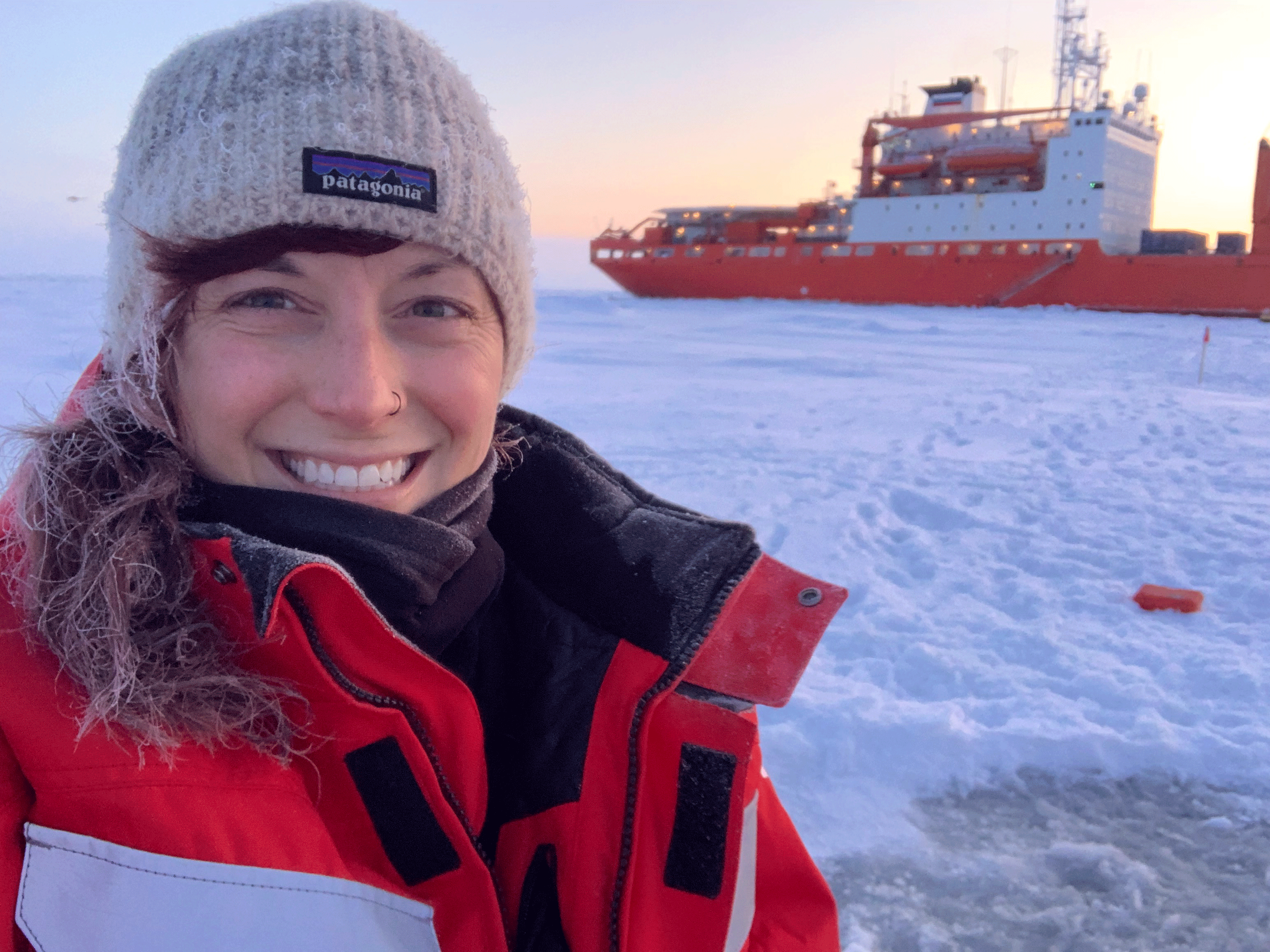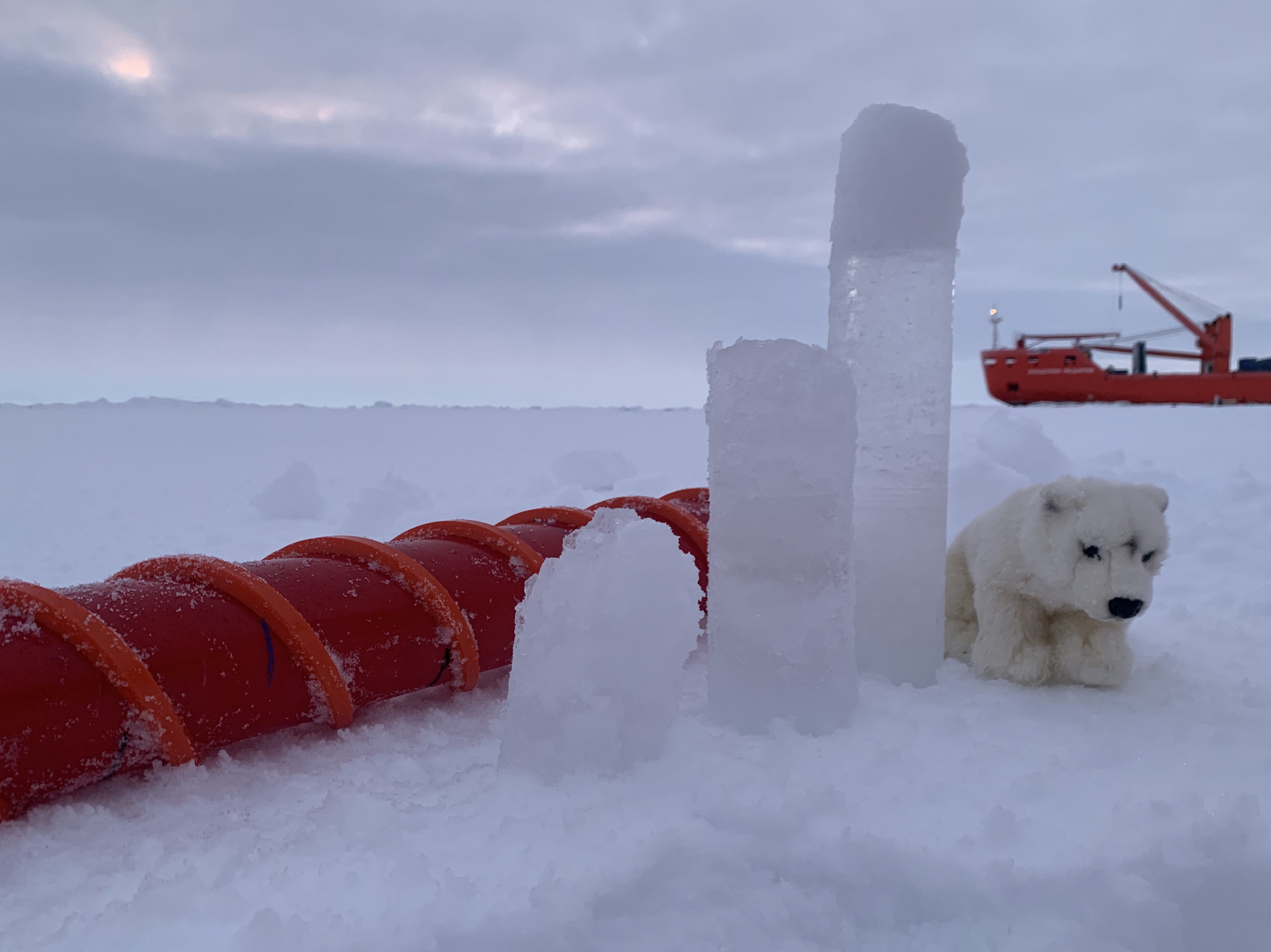Jessie Creamean: Sampling Central Arctic Aerosols
Published: 20 July 2020
An atmospheric chemist investigates the role of biological particles in aerosol-cloud interactions during the MOSAiC expedition

By now, in the summer of 2020, most people reading the news are familiar with the Multidisciplinary Drifting Observatory for the Study of Arctic Climate (MOSAiC), an international expedition that is the best-equipped all-season investigation of the central Arctic ever attempted.
However, news accounts so far have not included what was missing from MOSAiC, now in its fourth “leg”―or rotation―of personnel.
You guessed it: Pizza. And kale. And two golden retrievers named Whiskey and Montana.
All that is what atmospheric chemist Jessie Creamean missed. The Colorado State University researcher went out on MOSAiC’s Leg 1, spending most of her time aboard the German research icebreaker R/V Polarstern.
She left the United States on September 14, 2019, and returned January 5, 2020―by then inured to the deep cold of the polar night.
“You come back,” says Creamean, “and you think the cold January temperatures in Colorado are warm.”
Every time she set out on the ice to do science near the Polarstern, she had on extreme-weather clothing she compared to “wearing five sleeping bags.”
Back home now, Creamean has had a few slices of vegetarian pizza and has eaten kale at almost every meal. But with her golden retrievers resting nearby, she is also busy in her home office coordinating a massive aerosol collection project during the remaining legs of MOSAiC.
A Big Picture of Ice-Nucleating Particles

The U.S. Department of Energy (DOE) funded Creamean’s science. DOE’s Atmospheric Radiation Measurement (ARM) user facility funded her main onboard instrumentation, and DOE’s Atmospheric System Research (ASR) underwrote her science. (Creamean’s berth aboard the Polarstern, however, came from National Science Foundation money.)
The core of her MOSAiC research was to deploy instruments that would collect data on aerosol-cloud interactions. That included looking into the abundance, sizes, and sources of aerosols in the central Arctic. Creamean is particularly interested in ice-nucleating particles (INPs) and the contribution of INPs from both biological and mineral sources.
INPs are tiny particles linked to cloud formation and which have big influences on cloud reflectivity and lifetimes. They can be inorganics such as mineral dust or organics from soil, leaf bacteria, marine microbes, and other sources. Despite their importance to the water cycle, INPs are found only in scant numbers among particles in the atmosphere.
Creamean is one of two Colorado State INP experts ARM hired in the spring of 2020 to analyze INP samples from ARM observation sites and campaigns. Any analysis she does for MOSAiC is funded through her ASR project.
During MOSAiC, “we’re getting a big picture of INPs,” says Creamean, who is poised in Colorado to receive samples from the expedition throughout 2020. “We especially don’t have a ton of information on biologically derived INPs from the central Arctic. We think they may play a big role all year when open water is present, such as leads or melt ponds.”
Rare Science
“It’s uncharted territory.”
Jessie Creamean on wintertime aerosol measurements in the central Arctic
To investigate INP sources, Creamean collected samples from high and low: water deep in the ocean, melt ponds and sea ice leads at the surface, snow from different depths, sea-ice cores, and from the air in the form of filter samples. Those came from instruments onboard the Polarstern as well as suitcase-size devices that could be dragged out onto the ice and deployed in intriguing places. (Creamean dubbed her yellow-cased portable sampler “C3PO.”)
At one point during Leg 1, Creamean set up C3PO near a small crack in the ice.
“The goal was to try to capture any aerosols directly from the open-water sources,” she says, “to see if the open water was emitting any aerosols, and particularly, INPs.”
The main aerosol samplers are an ARM-operated DRUM impactor and total aerosol filter sampling apparatuses mounted on the ship’s bow.
Creamean focused on the idea that marine biology plays an important role in clouds―including bacteria whose proteins make them efficient INPs.
“It’s uncharted territory,” she says of the foray into biological INPs. “These were the first wintertime measurements in the central Arctic.”
Creamean has joined a legion of scientists wowed by unique MOSAiC data. Until the official start of the expedition in October 2019, yearlong sets of such rare measurements were unheard of in the central Arctic.
Microbes Going Airborne

Other researchers did studies of biological INPs decades ago in the high Arctic, says Creamean. But the measurements were not as detailed and were collected in just one season, summer.
This time around, the quality of aerosol instrumentation on MOSAiC will provide a more comprehensive picture of aerosols and INPs in the central Arctic.
“There is a lot of sun and exposed water now,” Creamean says of arctic summer, when MOSAiC’s Leg 4 is underway. “Microbes are probably becoming airborne.”
As samples trickle in from the Polarstern’s location, painstakingly shipped back from the ice starting with a shuttle fleet of icebreakers, Creamean is poised for a long-term analysis project.
Samples come in three varieties. There are 68 total aerosol filter samples from Leg 1. There are source samples from seawater, snow, and ice―938 as of late June 2020. There are also 916 size-resolved aerosol samples divided into four size ranges. The aerosols are as large as 12 microns in diameter (about 20 percent the width of a human hair) to as small in diameter as 130 nanometers, or about the width of 13 strands of DNA.
“We don’t have a ton (of INP samples) right now, but we have a lot more coming,” says Creamean, who keeps a master sample log and coordinates shipping with the Alfred Wegener Institute in Germany, the MOSAiC organizer. “It’s a big effort and can be hard to coordinate from my home in Colorado. I am grateful for all my colleagues onboard during the various legs who are helping out with my sample collections.”
She and her Colorado State team started processing samples in late June.
Good data are always a grand prize, says Creamean. So are many pictures of her Arctic Ocean companion, Bjorn the Bear. About the size of a fur muff, he is now a MOSAiC gift for her new niece―born just as Creamean was leaving for the central Arctic.
She says: “I took a ton of pictures of Bjorn doing science on the ice with me.”
See a March 2020 Jessie Creamean interview and presentation on her work and work life during MOSAiC.
For more, read MOSAiC blogs Creamean wrote for ARM:
Keep up with the Atmospheric Observer
Updates on ARM news, events, and opportunities delivered to your inbox
ARM User Profile
ARM welcomes users from all institutions and nations. A free ARM user account is needed to access ARM data.


















